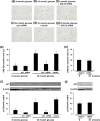Hyperglycemia causes cellular senescence via a SGLT2- and p21-dependent pathway in proximal tubules in the early stage of diabetic nephropathy
- PMID: 24996978
- PMCID: PMC4153757
- DOI: 10.1016/j.jdiacomp.2014.05.010
Hyperglycemia causes cellular senescence via a SGLT2- and p21-dependent pathway in proximal tubules in the early stage of diabetic nephropathy
Abstract
Aims: Kidney cells in patients with diabetic nephropathy are reported to be senescent. However, the mechanisms that regulate cellular senescence in the diabetic kidney are still unknown. In the present study, we evaluated the contribution of high glucose to renal cell senescence in streptozotocin (STZ)-induced diabetic mice.
Methods: Non-diabetic and streptozotocin (STZ, 10mgkg(-1)day(-1) for 7days, i.p.)-induced type 1 diabetic C57BL/6J mice and cultured human proximal tubular cells were used in this study.
Results: Hyperglycemia dramatically increased the renal expression of p21 but not other CDK inhibitors such as p16 and p27 at 4weeks after STZ injection. These changes were accompanied by an increase in senescence-associated β-galactosidase staining in tubular epithelial cells. Administration of insulin at doses that maintained normoglycemia or mild hypoglycemia suppressed the changes induced by STZ. Insulin did not affect the senescent markers in non-diabetic mice. Exposure of cultured human proximal tubular cells to 25mmol/L, but not 8mmol/L, glucose medium increased the expression of senescence markers, which was suppressed by knock-down of p21 or sodium glucose cotransporter (SGLT) 2.
Conclusions: These results suggest that hyperglycemia causes tubular senescence via a SGLT2- and p21-dependent pathway in the type 1 diabetic kidney.
Keywords: Cellular senescence; Diabetic nephropathy; Insulin; Proximal tubular cells; Sodium glucose cotransporter 2; p21.
Copyright © 2014 Elsevier Inc. All rights reserved.
Conflict of interest statement
Disclosure: There is no conflict of interest in this study.
Figures





References
-
- Al-Douahji M, Brugarolas J, Brown PA, Stehman-Breen CO, Alpers CE, Shankland SJ. The cyclin kinase inhibitor p21WAFl/CIPl is required for glomerular hypertrophy in experimental diabetic nephropathy. Kidney International. 1999;56:1691–1699. - PubMed
-
- Campisi J. Senescent cells, tumor suppression, and organismal aging: good citizens, bad neighbors. Cell. 2005;120:513–522. - PubMed
-
- Chuang TD, Guh JY, Chiou SJ, Chen HC, Hung WC, Chuang LY. Sp1 and Smad3 are required for high glucose-induced p21 (WAF1) gene transcription in LLC-PK1 cells. Journal of Cellular Biochemistry. 2007;102:1190–1201. - PubMed
-
- Fan YY, Kohno M, Hitomi H, Kitada K, Fujisawa Y, Yatabe J, et al. Aldosterone/Mineralocorticoid receptor stimulation induces cellular senescence in the kidney. Endocrinology. 2011;152:680–688. - PubMed
-
- Hayflick L. Living forever and dying in the attempt. Experimental Gerontology. 2003;38:1231–1241. - PubMed
Publication types
MeSH terms
Substances
Grants and funding
LinkOut - more resources
Full Text Sources
Other Literature Sources
Medical

